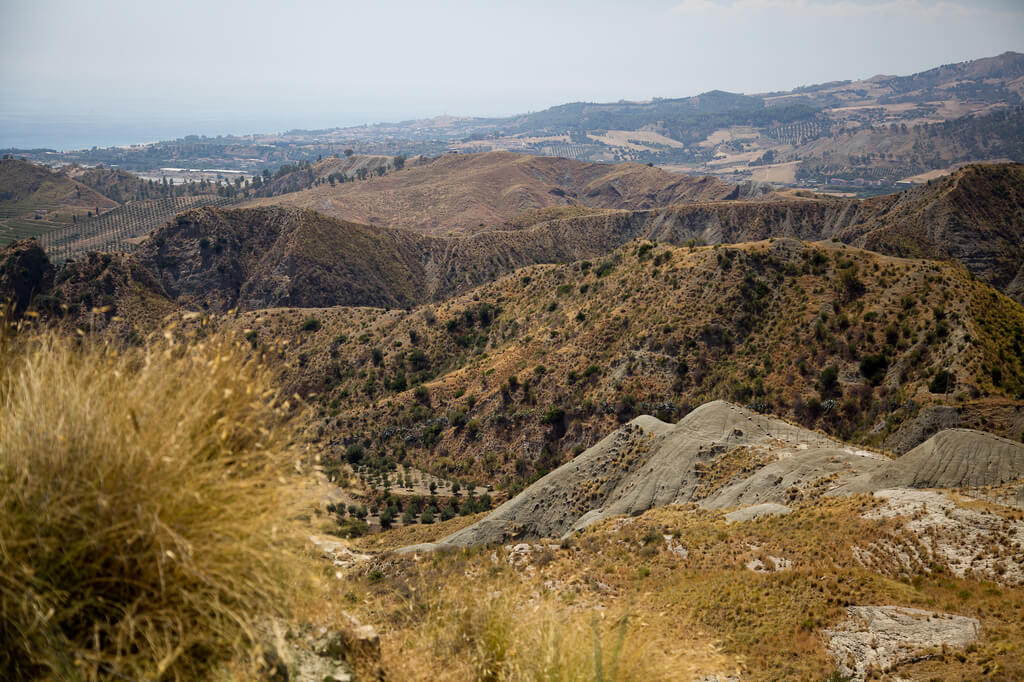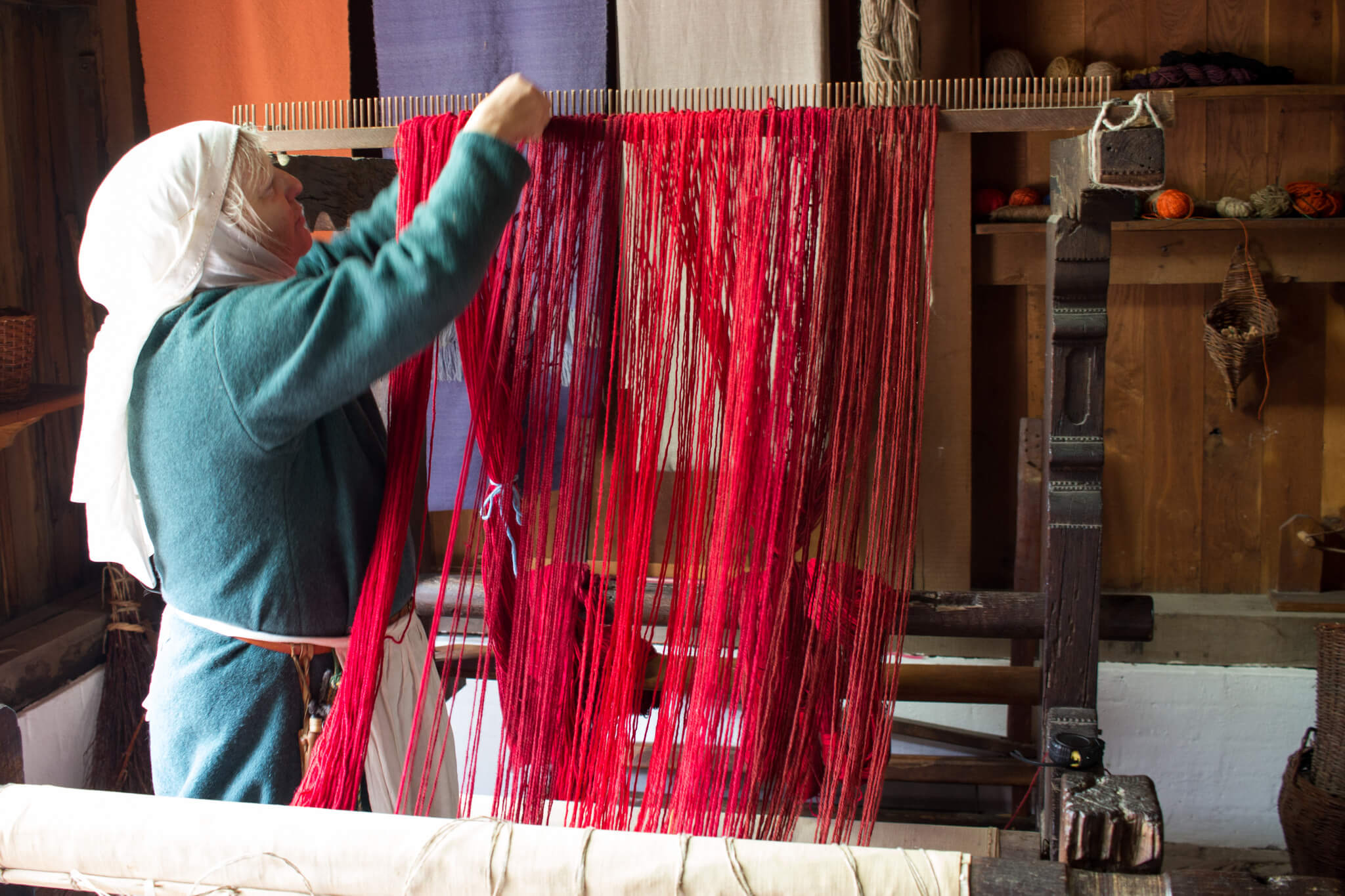In many parts of Calabria, the memory of the majistre, traditional textile mentors, is still alive. Historically, only women knew how to prepare the weaving looms. They were also the only ones who knew the cunti, stories that they would sing to accompany the process. It was difficult work: up to 1800 threads could pass through each loom and it was their manual skills that would determine the success of the product.
The majistre conserved this complex and sophisticated art for centuries, like priestesses. Other weavers, who were using looms every day, had virtually no access to their knowledge. And so things were until the modern age when sewing machines made the secrets of almost all of the majistre superfluous, and the looms that most families had in their homes became useless. Behind this adverb ‘almost’ is a hidden story of ransom and resistance, told against a plethora of criminal stereotypes.
This is the story of a group of young people from the anti-mafia movement in Locride, who had the initiative to dust-off the old looms and go in search of the few majistre that are still alive. They knew the local market wouldn’t be sufficient to pay the workers a fair wage so they came up with a practical solution. The only way to salvage the tradition, they concluded, was to produce high quality products for a high end market.
They gathered the secrets of the very last teachers, and those who wanted to learn the trade. Then they created a network of weavers, recovered the old looms and started to make modern clothing with traditional designs.
A heritage to save
Through this initiative a new ‘eco-ethical’ brand was born. The production was not just artisanal, the textiles themselves were rigorously organic, the work was well paid and the mafia kept at bay. They called it Cangiari, which, in the local dialect, means ‘change’. Chiara Pirroncello is one of their collaborators. I went to visit her in her laboratory in Chiaravalle, a small town in the province of Catanzaro in the Calabrian mountains.

Chiara is one of the inheritors of the old textile tradition, along with a very small group of women who are united by their shared will to rebuild it. Like many in Calabria, she struggles against the gloomy stereotypes of Southern Italy. At the same time, through her activities, she refutes the widespread resignation. She is dynamic, has strong links with her origins but knows how to recognise what is wrong in the region, and is aware of what’s going on in the world. Like many young people in Calabria she emigrated, but, unlike most she came back.
She did so with the specific intention of preventing an entire heritage from disappearing, together with the ancient majistre and the old weavers. Her mother was the last hand weaver in Chiaravalle. When Chiara told her that she wanted to learn the secrets of the art, her mother responded, “if you want to learn, you first have to get yourself a loom.” She found two in the family, without much difficulty. The oldest, from the 17th Century, belonged to her cousin’s grandmother, and was lying disassembled in a cellar; the other, which until fifty years ago was used in every house to weave wedding dresses or everyday linen, belonged to her cousin’s cousin. From these two, she had a carpenter make a new model. The hardest thing was learning to use them.
“The only source was my mother, who was a weaver, but not a majistra” she says. To explain how reluctant the majistra were to pass on their knowledge she tells an anecdote: “once my mother needed to repair a broken piece on the loom, and she asked the majistra to give her a complete piece so she could take it to a carpenter to make her a copy. But the woman kept making excuses over and over, and it was clear she didn’t want to hand it over. So one day, when the majistra was out, my mother went to the woman’s house and borrowed it from her husband. She got it copied and returned it back in time.”
Chiara’s mother didn’t know the songs that the majistra used to distinguish one weave from another. Her skill was based on practice and repetition. “She stole a lot of secrets by watching the preparation of the loom” she explains. Only occasionally did she need “basic writings, symbols scribbled on pieces of paper” to distinguish between one combination and another.

“If you are not a majistra with years of experience and everything in mind, it is very difficult” says Pirroncello. So she transcribed all that her mother had taught her, and then did a textile course in Modena, in Northern Italy, where she lived for four years. Now she’s able to do everything herself: prepare different combinations of weaves, set up the loom and make traditional textiles.
Pirroncello sits at the oldest of the looms to show me how you create a weave. The threads need to slacken and then be twisted in a cone shape, otherwise there’s a risk that the whole thing will come undone. If you make a mistake in one of the preparatory phases it will haunt you until the end. “If it is serious, you have to restart… otherwise you can use mistakes in a creative way” she tells me. The traditional patterns, she says, are so many and so similar because they are the result of little inaccuracies and idiosyncrasies of the looms.
On top of the difficulty of finding people who know the secrets of using a loom by hand, not to mention the long process and expenses, there is also the problem of finding the primary materials to satisfy demand. In the past people were cultivating, collecting and spinning linen regularly. In the hardest times, broom – a coarse yellow flower otherwise used to make sacks and resistant bags – was used for clothing, while shepherds provided wool.
Chiara had difficulty finding materials because nobody has linen flowers in their garden anymore, broom is out of fashion and the sheep are in short supply. Given that you need a few days to prepare this work, and that it takes six hours to produce just one metre of textile, it’s easy to see why the looms ended up gathering dust and mould in the cellars for so long.
Not just the ’ndrangheta
The heart and mind of the eco-ethical brand ‘Made in Calabria’ is in Gioiosa Ionica, a small town a few kilometers from the coast. Unlike Siderno or Locri, Gioiosa is famous as a place where ’ndrine – footsoliders of the Calabrian mafia the ’ndrangheta – have historically thrived.
In the 70s this town, in the province of Reggio Calabria, was governed by a communist mayor Ciccio Modafferi together with the support of a clergyman, don Natale Bianchi. In December 1975 Modafferi organised a strike against the mafia, and two years later would lead a civil case into the murder of a left-wing miller, Rocco Gatto. In retaliation the mafia imposed a lockdown on traders in the Sunday market. Bianchi, meanwhile, a clergyman close to liberation theology – with emancipating the oppressed – attracted hostility from both clans and church for opposing don Giovanni Stilo, the infamous ‘godfather priest’.
Today, all that remains of those times is a mural dedicated to the young millar on the walls of the old theatre in the town’s main square, which, emerging from a network of small streets, marks the start of a large boulevard filled with shops. More or less half way along are the offices of the Goel group, part of the cooperative ‘Made in Goel’ which manages the Cangiari label. With 201 full-time employees, and dozens of collaborators, the Goel group is a true colossus in Calabria, opposing the various clans.
There are ten social cooperatives, with profits distributed collectively, and two traditional ones (aimed at fulfilling the interests of their members), two associations, a foundation and 28 companies. Across Locride, Goel manages two community centres for people with mental health problems, three centres for children and a few for migrants and refugees.
There’s even an agriturismo (a countryside B&B) involved in the group at Monasterace – which hasn’t closed even for a day despite seven attempted arson attacks – and a hostel which opened in Locri in a small villa confiscated from a mafioso. It was taken into collective management when nobody responded to the local government’s call to take it on. Goel is also involved in responsible tourism, producing bio cosmetics and managing land confiscated by the mafia. In their citrus groves there is no ‘black’ work and their oranges are sold for 40 cents a kilo, significantly cheaper than the market price.
The idea for all this came from Vincenzo Linarello who agreed to meet me in his office at Gioiosa Ionica. In fact we met a couple of years ago in Rome when he presented the Cangiari brand during a fashion show organised by the humanitarian organisation Action Aid.
After years of study into the ’ndrangheta, Linarello and his group realised that “like all kinds of wild-west capitalism, 90% of mafia resources end up in the hands of 10% of the affiliates.” This means that only a few of them are rich. Those few then point “to the others”, to the second and third ranks of clans and their families, “searching to make conflicts within these groups.”
The turning point was understanding that in Calabria “Precarity has always been an instrument of governance. It is created and fed into as a system. The ’ndrangheta use it to create a tank of votes, and to bribe politicians to put their affiliates and supporters in key roles in the administrations where they are able to enable other small favours.”
The numbers of the system
This is how it was for at least forty years, from when, in the middle of the 70s, the principle clans made an agreement to change the method of governing the territory by bringing in two new ranks into the criminal hierarchy: Santista (Servants of the Madonna) and Vangelo (Gospel). These agents had the task of embedding themselves in the masonic lodges and making alliances with occult powers. At that moment, as the journalist Antonio Nicaso and the judge Nicola Gratteri detail in their book Fratelli di sangue (Blood Brothers), the very rites of initiation were transformed.

According to the authors the revenue of the ’ndrangheta today accounts for 2.9% of Italy’s national GDP, “more than the wealth produced by a country that has oil like Qatar.” Calabria, meanwhile, finds itself last in the country in terms of employment and income. The numbers collected by the judge – who as head attorney of Catanzaro has caused the ’ndrangheta a lot of problems, arresting 950 people in 2016 alone – are staggering: there are 10,000 members and 132 clans in Calabria, and the people who gravitate around the ’ndrine are estimated at “a few tens of thousands.” The criminal density, the relation of affiliates to the population, is, according to the authors, around 27% in Calabria, 12% in Campania, 10% in Sicily and 2% in Puglia.
To destroy this system, we need to “demonstrate that you can work without passing through a relationship with the mafia” asserts Linarello, figurehead of a Calabria that doesn’t want to be involved any longer with mafia and archaic codes, omerta’ and silence, violence and corruption. In Gioiosa Ionica he has created a “community of liberation”, made up of people that have decided to live together, putting their economic resources in common.
“From the very beginning we considered it necessary to come together and offer people concrete proposals. Historically, anti mafia moments have been founded solely on protest. After such protests people would go back home to their everyday lives and nothing would change. Ours was a political-cultural programme based on facts: we created pilot experiences that show how ethical approaches are not only right, but can be effective. We have shown how the ’ndrangheta is unfair and ineffective” says Linarello.
The model has worked. Today Goel is a reality that is able to resist all forms of intimidation. “They attack us because they know we have a consensus, but we have developed an effective strategy: when they strike we don’t remain silent but we square things up, we organise a party to get things going again, and publicly say: come and hit us again, because you’re only making us stronger” he adds.
I ask him where the idea for an ethical high fashion brand came from. “When we decided to recuperate the ancient tradition of textile production with the hand loom, we did some sums and realised that if we wanted to reimburse the work properly we couldn’t rely on the local market but had to go higher up” he explains. The gamble paid off. Cangiari uses organic textiles, rebuilds a tradition that was believed to be lost, and creates work for women in a region with the lowest employment rate in Europe (42.1%), a fact which in large part is down to the fact that two out of three women in the region have no work.
A creative community
If the mind of Cangiari can be found in the office of the Goel group, its heart is in a kitch villa, confiscated from the ’ndrangheta and assigned to the cooperative. It’s located nearby at the end of a closed-off street in Gioiosa Ionica. In the atrium, between marble arches and a pompous wood stove, are a few mannequins dressed in wedding clothes, ready to leave for the show room that Cangiari has recently opened in the centre of Milan (another building confiscated from the ’ndrangheta). When I arrive, Manuela Sfondrini and her production assistant Stefania De Stefano are re-organising the lab so the production is at a standstill.
They tell me that beyond producing textiles directly, from here they coordinate the network of weavers in the Calabrian countryside and the two laboratories at Cittanova and Ardore which employ over fifty people, alongside the traditional workers. Aside from Cangiari they work for other major Italian fashion brands, and manage to maintain a constantly active production cycle. Amano describes it as “a creative community”, in which the role of the stylist, unlike elsewhere, is not decisive.
The turnover is very high: the 2017-18 collection is signed by Maria Paola Pedetta. Previously it had the touch of the Swede, Paulo Melim Andersson. Soon it will change again. Presenting itself as a brand that has challenged the ’ndrangheta on its own turf, Cangiari has travelled the world, from Paris to Tel Aviv, from Arab fashion week in Abu Dhabi to Milan’s Fashion revolution day.
At the Rome event with Action Aid, the clothes line was signed by the stylist Marina Spadafora, already a winner of the Women Together award by the United Nations for her efforts in ethical fashion. At the end of the evening the film director Andrew Morgan presented the documentary ‘The True Cost’, which shows the environmental, social and human costs of clothing production that big multinationals hide, from the disaster of Rana Plaza in Bangladesh to the exploitation of textile workers in Cambodia. This time, for once, Calabria was presented as a model to imitate.
* This article was first published in Internazionale. It was translated from Italian by Jamie Mackay.
** Lead Image: J.Feist. Flickr/Some rights reserved
![Political Critique [DISCONTINUED]](https://politicalcritique.org/wp-content/uploads/2015/09/Political-Critique-LOGO.png)
![Political Critique [DISCONTINUED]](https://politicalcritique.org/wp-content/uploads/2015/09/Political-Critique-LOGO-2.png)